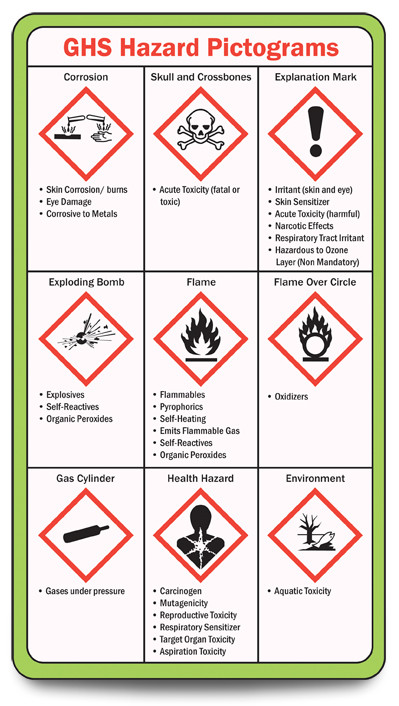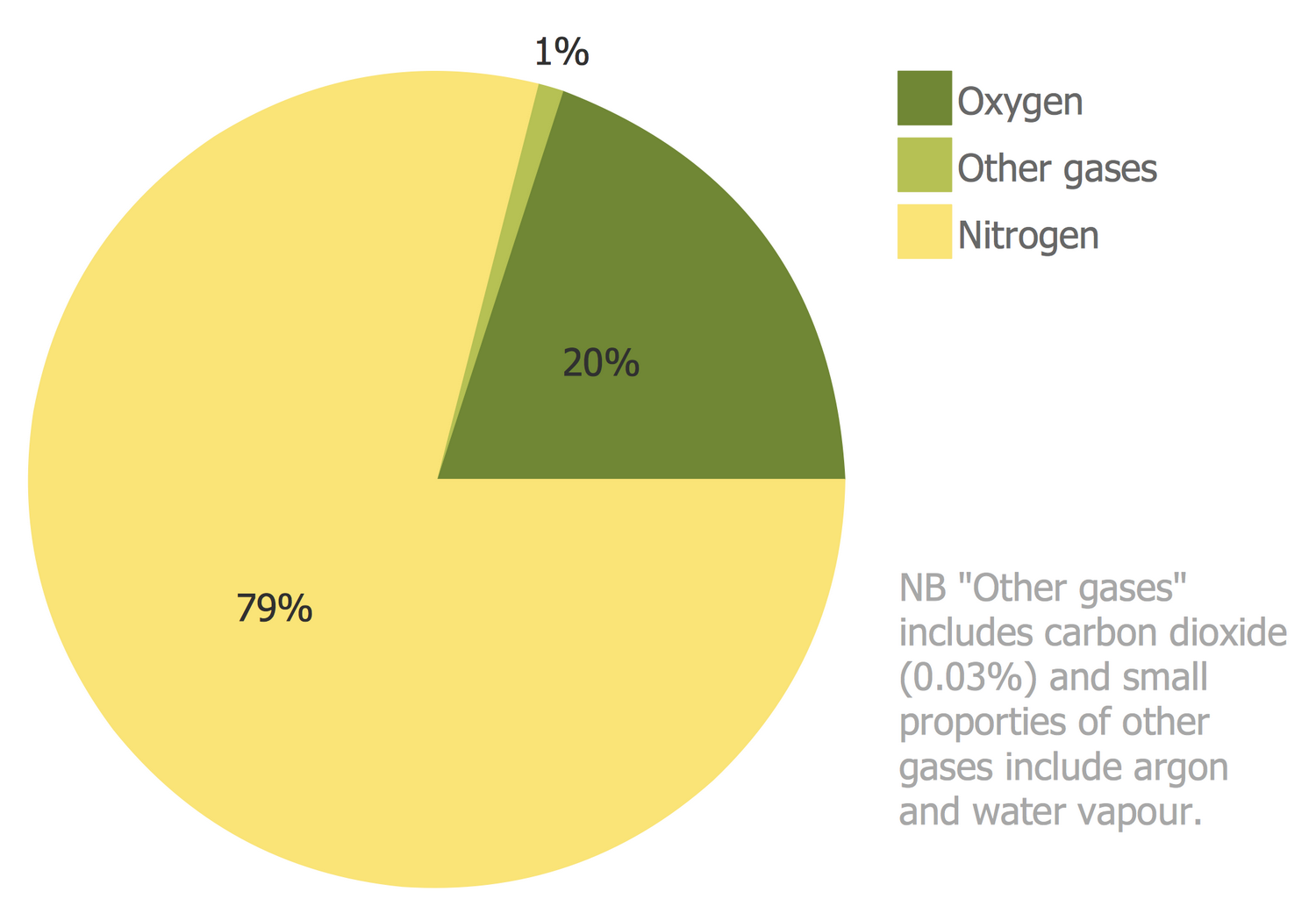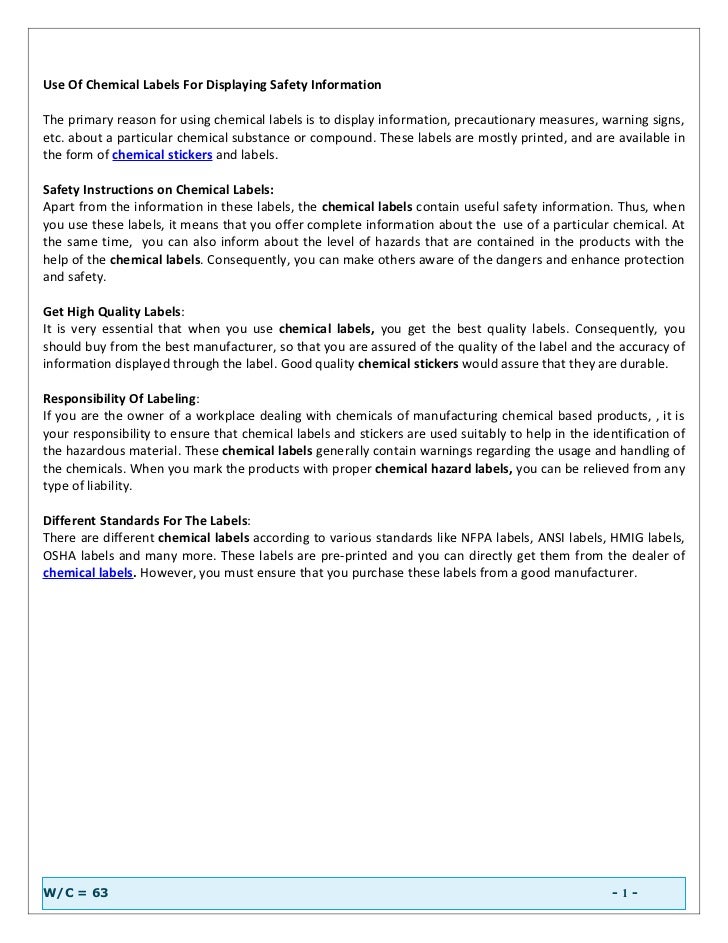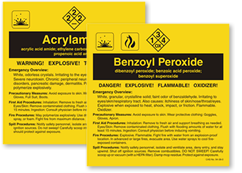38 chemical labels provide what information
What are GHS Safety Data Sheets? - iacs Safety data sheets (SDS) are a critically important part of the GHS and global chemical safety. They provide extensive information on a substance, its supplier and the safe handling and use of it. You are then able to conduct chemical risk assessments around your workplace and ensure that each area is safe for work. Chemical labeling Flashcards | Quizlet Also known as SdS are the cornerstone of chemical hazard communication and central to the safe handling of hazardous substances Eight things and SDS sheet includes 1. Product identification 2. hazardous ingredients 3. physical and chemical characteristics 4. fire and explosion hazard 5. reactivity data 6. health hazard data
What Required Information Must GHS Labels Include? - MPC Product identification - A product identifier is used to disclose the chemical's or product's name. If additional identifiers are needed beyond the product name, these identifiers can be placed to the right of the manufacturer's information on a GHS label. Understanding GHS Pictograms

Chemical labels provide what information
Understanding Safety Data Sheets (SDS) and Product Labels When required a new label will include a harmonized signal word, pictogram, hazard and precautionary statements. All SDS for our chemical products are arranged into sixteen sections that will easily explain the hazards of the chemical products in a concise manner (Figure 3). The following explains the contents of each section. PDF BRIEF - Occupational Safety and Health Administration The label provides information to the workers on the specific hazardous chemical. While labels provide important information for anyone who handles, uses, stores, and transports hazardous chemicals, they are limited by design in the amount of information they can provide. Safety Data Sheets (SDSs), which must accompany hazardous chemicals, are ... Chemical Safety: Labels and SDSs - Washington State University Chemical Container Labeling Every chemical container must be labeled by the manufacturer or supplier with general information on the potential hazards and how to use the product safely. The label at a minimum must have the: name of the product, name and address of the manufacturer, and the physical and health hazards associated with the product.
Chemical labels provide what information. WHMIS 2015 - Labels : OSH Answers The supplier label must include the following information: Product identifier - the brand name, chemical name, common name, generic name or trade name of the hazardous product. Initial supplier identifier - the name, address and telephone number of either the Canadian manufacturer or the Canadian importer*. Quick & Dirty Guide to GHS Chemical Labels | Avery.com The nature of the hazard must be described on GHS chemical labels. Globally standardized symbols convey health, physical and environmental information to transcend language barriers. Supplier Identification. GHS chemical labels must include name, address and telephone number of the supplier. Precautionary Statements. Information on hazardous chemical labels | Safe Work Australia A hazardous chemical is correctly labelled if it is packed in a container and has a label written in English. Pictograms and text on the label should be clear. The label must also be firmly fixed to the hazardous chemical’s container. It should not be hidden or in a spot where it could be removed, such as on the lid. What are the 6 Elements of a GHS Label? - Computype This component of the GHS label is typically placed in the top left-hand corner of the label, and it identifies the hazardous chemical or ingredient that is in this product. It can state the name, code number, or batch number. This allows for the chemical to be confidently identified. 2. Signal Word
A Guide To Labeling Systems For Chemicals 21.12.2019 · HCS & GHS Labels: Chemical Labeling Regulations for Hazard Information. OSHA’s Hazard Communication Standard (HCS) follows the United Nations’ Globally Harmonized System of Chemical Labeling (GHS). HCS compliant labels have four sections: A harmonized signal word. “Danger” is used for severe hazards, and “warning” for less severe hazards. Understand the labels - Chemicals In Our Life - ECHA A hazard pictogram is an image on a label that includes a warning symbol and specific colours intended to provide information about the damage a particular substance or mixture can cause to our health or to the environment. The CLP Regulation has introduced a new classification and labelling system for hazardous chemicals in the European Union. Chemical Container Labels | EHS The Hazard Communication Standard requires secondary chemical container labels contain at least the following information: Identity of the contents (spell out chemical names) Signal word, if known or suspected (e.g., "danger", "warning") Hazards, if known or suspected (e.g., "flammable", "corrosive", "irritant") Labeling requirements of hazardous chemicals. 14.06.1993 · The using employer has the responsibility to ensure that each container of hazardous chemical in the workplace is labeled, tagged, or marked with the following information: i) Identity of the hazardous chemical(s); ii) Appropriate hazard warnings. Ms. Dietrich's letter indicates that Dr. Dietrich's office is labeling all hazardous chemical containers.
Hazardous Materials Identification (HMIS) | Graphic Products The Hazardous Materials Identification System (HMIS) is a hazard rating system that uses color bar labels to identify and provide information about chemical hazards. It was developed by, and is proprietary to the National Paint Coatings Association (NPCA), now known as the American Coatings Association (ACA). Chemical Labels | Web's largest array of Hazcom and HazMat Labels Every year, almost 5% of workers suffer chemical exposures that cause temporary symptoms, permanent injury, debilitating illness, or, even, death. To protect workers from such exposures, we offer the web's largest array of easy-to-understand and complete HazCom labels - all with web-best prices, superior durability and compliant designs. A Guide to OSHA's New GHS Chemical Labeling Requirements The GHS-inspired standards will require chemical manufacturers and importers to label chemical containers with 1) a harmonized signal word 2) GHS pictogram (s) 3) a hazard statement for each hazard class and category and 4) a precautionary statement. These elements are discussed in greater detail below: RTK Test - USG True or False: Chemical Container Label Contents Chemical container labels provide critical information that identifies hazards associated with the product. True False Select an answer to continue.

The Q Source Resource: Hazard Communication: Everything You Need to Know – Guest Blog - Industry ...
Chemical Container Labels | EHS Chemical container labeling is one of the most effective and efficient ways to communicate hazard information to your coworkers and prevent accidents and injuries. Clear and consistent labeling that follows the Hazard Communication Standard is required in all University of Washington facilities including laboratories, shops, clinics, and other locations where …
GHS Labeling Requirements: The Definitive Guide [2021 Update ... - Luminer These sheets provide important information about chemical hazards through 16 different sections, including: Identification Hazard Identification Composition/Information on Ingredients First-Aid Measures Fire-Fighting Measures Accidental Release Measures Handling and Storage Exposure Controls and Personal Protection
Labelling of chemicals - OSHWiki Labelling of chemicals is based on their classification, which involves determining the hazard category to which the chemical belongs and assigning a codified regulatory phrase describing the type of hazard (hazard statement according to the CLP regulation, risk phrase in the pre-existing European regulations) (see chapter 'CLP regulation' below).
Introduction to Pesticide Labels | US EPA Pesticide product labels provide critical information about how to safely and legally handle and use pesticide products. Unlike most other types of product labels, pesticide labels are legally enforceable, and all of them carry the statement: "It is a violation of Federal law to use this product in a manner inconsistent with its labeling."
Understanding the NFPA 704 Diamond Labeling System Recognizing NFPA 704 Diamonds. The NFPA 704 label contains an incredible amount of information in a compact and easy-to-understand format. This is essential for all emergency situations to be able to respond quickly. The label is made up of four smaller color-coded diamonds that make up one large diamond shape.
Understand the labels - Chemicals In Our Life - ECHA A hazard pictogram is an image on a label that includes a warning symbol and specific colours intended to provide information about the damage a particular substance or mixture can cause to our health or to the environment. The CLP Regulation has introduced a new classification and labelling system for hazardous chemicals in the European Union.
CCHLPI025 high temperature resistant label,high temperature labels manufacturer - Crystal Code ...
Labelling and packaging - Chemical classification - HSE Labelling and packaging Labels are there to help identify hazardous chemicals and explain what the hazards are and how to avoid them. Packaging is also important to ensure that chemicals are stored...
Cleaning Chemical Safety Information Some chemicals may arrive at the workplace in a concentrated form and often aren't intended for use at that level of potency. Make sure to pay attention to chemical labels and instructions from managers. If the smell of cleaning chemicals begins to bother you or you feel light-headed, take a break and make sure the room is properly ventilated.
Product Labels: How to Identify Chemicals and Other Ingredients This includes cleaners, car wax, battery acid, drain opener, and the like. These products are required to list their main ingredients that are known to be hazardous; and what not to do (e.g., don ...
Labelling of chemicals - OSHWiki Labelling of chemicals is based on their classification, which involves determining the hazard category to which the chemical belongs and assigning a codified regulatory phrase describing the type of hazard (hazard statement according to the CLP regulation, risk phrase in the pre-existing European regulations) (see chapter 'CLP regulation' below).
Bay Tech Label - Guide to Understanding Chemical Labels Hazardous chemicals require labels because they provide information about the chemicals and instructions on how to use the products safely. They're important to businesses such as importers and manufacturers because they tell them about the safety measures required to use these chemicals in the workplace.
Labeling Requirements | US EPA The label on a pesticide package or container and the accompanying instructions are a key part of pesticide regulation. The label provides critical information about how to handle and safely use the pesticide product and avoid harm to human health and the environment. Labeling Requirement Resources
Proper Labeling Chemical Containers - OSHA Review The chemical manufacturer must ensure that primary label is marked with the following information: Product identifier - The name or number used for a hazardous chemical on a label or in the safety data sheet (SDS). Signal word - A word used to indicate the relative level of severity of hazard and alert the user to a potential hazard.
Safety Data Sheets (SDS) Explained - Link Family Section 1 - Identification identifies the chemical on the SDS as well as the recommended uses. It also provides the essential contact information of the supplier. Section 2 - Hazard (s) identification includes the hazards of the chemical and the appropriate warning information associated with those hazards.
Chemical Container Labeling - Northwest Safety Chemical Container Labeling. The Hazard Communication Standard (HCS) describes chemical labels as information provided through a group of written, printed, or graphic appropriate elements concerning a hazardous chemical. These should be that placed on the immediate container of a hazardous chemical. The Hazard Communication Standard also is now ...
HazCom 2012: The GHS label requirements - Safety.BLR.com One of the GHS requirements is that chemical manufacturers and importers must provide a label on all shipped hazardous chemical containers that include a signal word, pictogram, hazard statement, and precautionary statement for each hazard class and category. HazCom 2012 includes the following additional major requirements:
Chemical Labels | Toolbox Talks | SafetyTek Chemicals are commonly used on construction sites, in factories, on mine sites and in laboratories. Ensuring chemical containers are correctly labeled reduces the risk of accidents and workplace injuries. In this toolbox talk, you can cover what to look for on chemical labels as well as how to correctly label a chemical container for future use.
Labeling requirements of hazardous chemicals. | Occupational Safety and ... The purpose of container labeling is to provide an immediate warning to employees of the hazards they may be exposed to and through the chemical identity, labels provide a link to more detailed information available through MSDS's and other sources.












Post a Comment for "38 chemical labels provide what information"